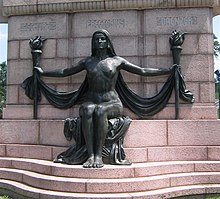Compton Hill Reservoir Park
| Compton Hill Reservoir Park | |
|---|---|
St. Louis Landmark
| |
| Location | St. Louis, Missouri |
| Built | 1898 |
| Architect | Harvey Ellis |
| Architectural style | French Romanesque |
| NRHP reference No. | 72001555 |
| Added to NRHP | September 29, 1972 |
38°36′51.84″N 90°14′13.96″W / 38.6144000°N 90.2372111°W Compton Hill Reservoir Park is a 36-acre (15 ha) public
History
James P. Kirkwood selected the site of the reservoir, one of the highest elevations within the 1855 city limits.[2] As the reservoir occupied only 18 acres (7.3 ha) of the site, Kirkwood suggested the remaining land be turned into a park.[1] The top of the reservoir structure was at one time covered with elevated tennis courts; presently, two newer tennis courts lie to the east.
The water tower was retired in 1929, after 30 years, when the Howard Bend Plant was put in service: the static head from the Stacy Park Reservoir, in what is now the St. Louis suburb of Olivette, caused an overflow of pure chemically treated water into the sewer system.[3] The reservoir and water tower were renovated, in 1999, at a cost of $19 million.[1]
In 1969, Interstate 44 was constructed through the northern edge of the park, reducing the area of the park to its present size.[1]
Compton Hill Water Tower

The Compton Hill Water Tower, built in 1898, is the youngest of three remaining stand pipe-
The Naked Truth

The statue The Naked Truth, unveiled in 1914, was a gift to the city of St. Louis by the
The statue was moved to its present location south of the water tower after Interstate 44 was constructed through the northern edge of the park.[6] The statue was designated a city landmark in 1969.[1]
See also
- Chicago Water Tower
- Louisville Water Tower
- Tower Grove East, St. Louis, nearby neighborhood that had a large German American population by the 1850s
- Tower Grove Park, the park located a short distance south on Grand Boulevard
References
- ^ St. Louis. Retrieved 2008-05-21.
- ^ Schworm, William B. "A History of the St. Louis Water Works". City of St. Louis Water Division. Archived from the original on 2008-08-28. Retrieved 2008-06-17.
- ^ a b c d e "National Register of Historic Places: Inventory - Nomination Form" (PDF). Missouri Department of Natural Resources. 1972-09-29. Retrieved 2008-05-30.
- OCLC 3704531. Retrieved 2008-06-16.
- ^ "Tower Openings". The Water Tower and Park Preservation Society. Archived from the original on 2008-06-13. Retrieved 2008-06-16.
- ^ St. Louis. Retrieved 2008-05-30.
External links
- Compton Hill Reservoir Park official site
- [1] Facebook page
- Compton Hill Water Tower - Compton Heights neighborhood page about the water tower
- The Water Tower and Park Preservation Society
- Built St. Louis: the Water Towers - Information about the three remaining water towers in St. Louis
